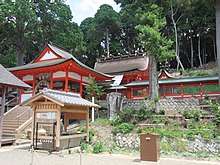Hiro Hachiman-jinja
Hiro Hachiman-Jinja (広八幡神社) (Hachiman Shrine in Hirogawa, Wakayama), formerly called “Hachimangū”, was famous as the shrine of Ubusuna-gami (God of Birth) among those people who lived in the seven villages of the Hiro estate. It consists of four buildings: Honden (main hall), Wakamiya-sha, Kora-sha and Tenjin-sha. The main hall enshrines Hondawake-no-Mikoto (Emperor Ojin), Tarashinakatsuhiko-no-Mikoto (Emperor Chuai) and Okinagatarashihime-no-Mikoto (Emperor Jingu). Wakamiya-sha enshrines Ohsagi-no-Mikoto (Emperor Nintoku), Kora-sha enshrines Tekenouchi-no-Sukune. And Tenjin-sha Sugawara no Michizane, a great scholar, calligrapher, poet and politician in the Heian period.
| Hiro Hachiman-Jinja (広八幡神社) | |
|---|---|
 Hiro Hachiman-jinja | |
| Religion | |
| Affiliation | Shinto |
| Location | |
 Shown within Japan | |
| Geographic coordinates | 34°1′3.7″N 135°10′31″E |
According to the Kii-Zoku-Fudoki (the sequel of ancient records in Kishu: Wakayama), it was originally built during the reign of Emperor Kinmei. In 1585, its treasure house and other buildings were burnt down during the war caused by Toyotomi clan. It went through tough times until Asano Yukinaga took over Kishu in 1600 and made an offer to expand its land and additional property tax (10 koku). Even after the Kishu Tokugawa (the Kii branch of the Tokugawa) started ruling Kishu, it was well protected financially over the years as Asano’s.
It is dedicated to Shintoist and Buddhist deities and has massha (sub shrine), Tahōtō (pagodas), Kagura-den (sacred dance hall), Shōrō (belfry) and Kannon-dō (Goddess of Mercy Halls) along with the buildings in the premises today. However, those buildings were ordered removed when the Separation of Shintoism and Buddhism came into effect in the Meiji era.
The current shrine buildings including the rōmon (two storied gate) were restored and have regained the splendor of the past.
Hiro Hachiman Jinja is unique because it includes the monument to the village’s hero: Goryo Hamaguchi. He is often called “Hamaguchi Daimyo-jin” by villagers and referred to as “A Living God” by Lafcadio Hearn in his Gleanings in Buddha Fields (1897), because of his bravery acts when a big tsunami struck the area in 1854. Its inscription was made by Katsu Kaishu and the calligraphy was written by Iwaya Ichiroku.